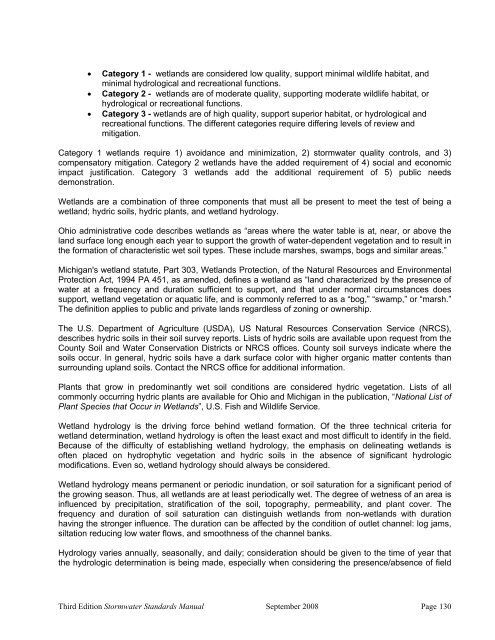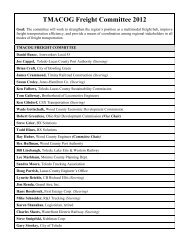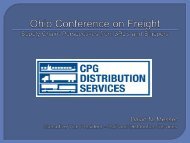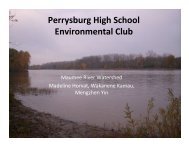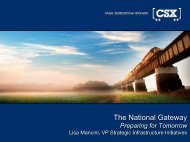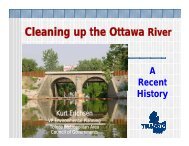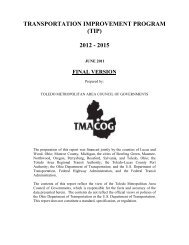Stormwater Management Standards Manual - Toledo Metropolitan ...
Stormwater Management Standards Manual - Toledo Metropolitan ...
Stormwater Management Standards Manual - Toledo Metropolitan ...
Create successful ePaper yourself
Turn your PDF publications into a flip-book with our unique Google optimized e-Paper software.
• Category 1 - wetlands are considered low quality, support minimal wildlife habitat, and<br />
minimal hydrological and recreational functions.<br />
• Category 2 - wetlands are of moderate quality, supporting moderate wildlife habitat, or<br />
hydrological or recreational functions.<br />
• Category 3 - wetlands are of high quality, support superior habitat, or hydrological and<br />
recreational functions. The different categories require differing levels of review and<br />
mitigation.<br />
Category 1 wetlands require 1) avoidance and minimization, 2) stormwater quality controls, and 3)<br />
compensatory mitigation. Category 2 wetlands have the added requirement of 4) social and economic<br />
impact justification. Category 3 wetlands add the additional requirement of 5) public needs<br />
demonstration.<br />
Wetlands are a combination of three components that must all be present to meet the test of being a<br />
wetland; hydric soils, hydric plants, and wetland hydrology.<br />
Ohio administrative code describes wetlands as “areas where the water table is at, near, or above the<br />
land surface long enough each year to support the growth of water-dependent vegetation and to result in<br />
the formation of characteristic wet soil types. These include marshes, swamps, bogs and similar areas.”<br />
Michigan's wetland statute, Part 303, Wetlands Protection, of the Natural Resources and Environmental<br />
Protection Act, 1994 PA 451, as amended, defines a wetland as “land characterized by the presence of<br />
water at a frequency and duration sufficient to support, and that under normal circumstances does<br />
support, wetland vegetation or aquatic life, and is commonly referred to as a “bog,” “swamp,” or “marsh.”<br />
The definition applies to public and private lands regardless of zoning or ownership.<br />
The U.S. Department of Agriculture (USDA), US Natural Resources Conservation Service (NRCS),<br />
describes hydric soils in their soil survey reports. Lists of hydric soils are available upon request from the<br />
County Soil and Water Conservation Districts or NRCS offices. County soil surveys indicate where the<br />
soils occur. In general, hydric soils have a dark surface color with higher organic matter contents than<br />
surrounding upland soils. Contact the NRCS office for additional information.<br />
Plants that grow in predominantly wet soil conditions are considered hydric vegetation. Lists of all<br />
commonly occurring hydric plants are available for Ohio and Michigan in the publication, “National List of<br />
Plant Species that Occur in Wetlands”, U.S. Fish and Wildlife Service.<br />
Wetland hydrology is the driving force behind wetland formation. Of the three technical criteria for<br />
wetland determination, wetland hydrology is often the least exact and most difficult to identify in the field.<br />
Because of the difficulty of establishing wetland hydrology, the emphasis on delineating wetlands is<br />
often placed on hydrophytic vegetation and hydric soils in the absence of significant hydrologic<br />
modifications. Even so, wetland hydrology should always be considered.<br />
Wetland hydrology means permanent or periodic inundation, or soil saturation for a significant period of<br />
the growing season. Thus, all wetlands are at least periodically wet. The degree of wetness of an area is<br />
influenced by precipitation, stratification of the soil, topography, permeability, and plant cover. The<br />
frequency and duration of soil saturation can distinguish wetlands from non-wetlands with duration<br />
having the stronger influence. The duration can be affected by the condition of outlet channel: log jams,<br />
siltation reducing low water flows, and smoothness of the channel banks.<br />
Hydrology varies annually, seasonally, and daily; consideration should be given to the time of year that<br />
the hydrologic determination is being made, especially when considering the presence/absence of field<br />
Third Edition <strong>Stormwater</strong> <strong>Standards</strong> <strong>Manual</strong> September 2008 Page 130


